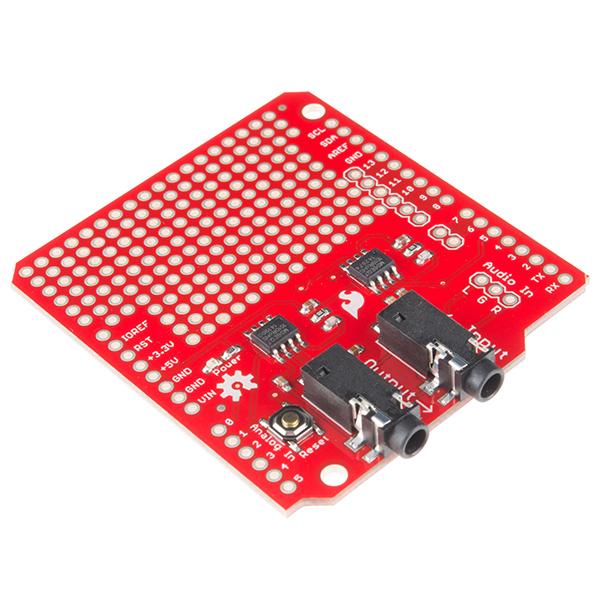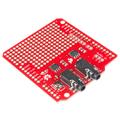SparkFun Spectrum Shield

Description Attachments
The SparkFun Spectrum Shield is a unique product that amplifies the capabilities of your Arduino by allowing it to split a stereo audio input into 7-bands per channel. This feature enables you to read the amplitude of each channel using the ADC on your Arduino, thereby controlling various devices from LEDs to motors, pumps to relays, or even fire, all with sound. In essence, the Spectrum Shield allows almost any project to react to music or sound.
The Spectrum Shield is equipped with the MSGEQ7 graphic equalizer display filter. This component enables the shield to split a stereo audio input into 7-bands per channel and read the amplitude of each using the ADC on your Arduino. The shield is also fitted with two 2.54mm stereo jacks, similar to those found on a pair of headphones. One jack serves as a stereo input while the other acts as a pass-through output. This allows you to connect the Spectrum Shield in-line between your audio source and your stereo system without any interruption. This version of the Spectrum Shield conforms to the Arduino R3 layout but does require you to solder on your own headers.
One of the main benefits of the Spectrum Shield is its versatility. It can be used to create sound visualizers, detect patterns in music or add sound activation to your microcontroller projects. This makes it a valuable addition to any Arduino setup, opening up a multitude of possibilities for sound-based projects.
The Spectrum Shield is a product of a collaboration with Ben Moyes of Bliptronics. A portion of each sale goes back to them for product support and continued development, ensuring the longevity and quality of the product.
For a comprehensive understanding of the SparkFun Spectrum Shield, a variety of documents are available including a schematic, Eagle files, a hookup guide, a datasheet for the MSGEQ7, and GitHub links for example code and design files.
Properties
| Brand | Sparkfun |
| Model | DEV-13116 |
| More info | Spectrum Shield Hookup Guide (v2) - SparkFun Learn |
| Length | 75 mm |
| Width | 90 mm |
| Height | 8 mm |
| Weight | 40,8 g |
Alternative products
Customer questions
Customer Reviews
- In stock Sparkfun Copper Tape - Conductive Adhesive, 5mm - 15 meter € 6,45 View product
- In stock Sparkfun Teensy Stackable Header Kit (Extended) € 2,40 View product
- In stock Sparkfun Hobby Motor - Gear € 2,90 View product
- In stock Sparkfun Battery Holder 2xAA with Cover and Switch - JST Connector € 2,15 View product
- Sale In stock -72 % Sparkfun EasyDriver - Stepper Motor Driver € 17,60 € 5,- View product
- In stock Sparkfun Thin Speaker - 4 Ohm, 2.5W, 28mm € 2,50 View product
- In stock Sparkfun Alligator Clip with Pigtail (4 Pack) € 5,- View product
- In stock Sparkfun Toggle Switch € 2,75 View product
- In stock Sparkfun Clear Plastic Knob € 1,45 View product
- In stock Sparkfun Resistor 1K Ohm 1/4 Watt PTH - 20 pack (Thick Leads) € 1,80 View product
- In stock SparkFun Logic Level Converter - Bi-Directional € 4,25 View product
- In stock SparkFun Serial Basic Breakout - CH340G € 9,50 View product
- In stock Sparkfun Super Capacitor - 10F/2.5V € 5,20 View product
- In stock SparkFun Nano Power Timer - TPL5110 € 9,05 View product
- In stock Sparkfun Mini Photocell € 1,90 View product
Recently viewed items
- SparkFun Spectrum Shield € 30,80 View product
- Opencircuit Arcade push button 30mm - white € 2,15 View product
- Velleman Diamond file set - 5pcs € 9,30 View product
- Pololu QTR-MD-03RC Reflectance Sensor Array: 3-Channel, 8mm Pitch, RC Output € 3,25 View product
- SparkFun ESP8266 Thing € 20,50 View product
- In stock DFRobot Gravity: Digital Microwave Sensor (Motion Detection) € 9,30 View product
- 10 pieces DFRobot Gravity: Digital Sensor Cable for Arduino (10 Pack) € 6,20 View product
- Sparkfun Audio Cable TRRS - 1ft € 3,05 View product
- SparkFun Micro OLED Breakout (with Headers) € 10,55 View product
- In stock DFRobot Gravity: WiFi IoT Module € 14,30 View product
- Sparkfun Fuse Clip 5mm € 0,45 View product
- PJRC Teensy 4.1 - Lockable € 40,70 View product










